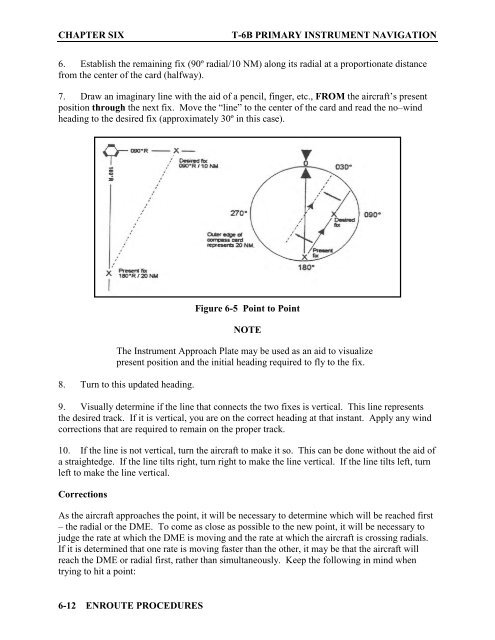Flight Training Instruction - Cnatra - U.S. Navy
Flight Training Instruction - Cnatra - U.S. Navy
Flight Training Instruction - Cnatra - U.S. Navy
You also want an ePaper? Increase the reach of your titles
YUMPU automatically turns print PDFs into web optimized ePapers that Google loves.
CHAPTER SIX T-6B PRIMARY INSTRUMENT NAVIGATION<br />
6. Establish the remaining fix (90º radial/10 NM) along its radial at a proportionate distance<br />
from the center of the card (halfway).<br />
7. Draw an imaginary line with the aid of a pencil, finger, etc., FROM the aircraft’s present<br />
position through the next fix. Move the “line” to the center of the card and read the no–wind<br />
heading to the desired fix (approximately 30º in this case).<br />
6-12 ENROUTE PROCEDURES<br />
Figure 6-5 Point to Point<br />
NOTE<br />
The Instrument Approach Plate may be used as an aid to visualize<br />
present position and the initial heading required to fly to the fix.<br />
8. Turn to this updated heading.<br />
9. Visually determine if the line that connects the two fixes is vertical. This line represents<br />
the desired track. If it is vertical, you are on the correct heading at that instant. Apply any wind<br />
corrections that are required to remain on the proper track.<br />
10. If the line is not vertical, turn the aircraft to make it so. This can be done without the aid of<br />
a straightedge. If the line tilts right, turn right to make the line vertical. If the line tilts left, turn<br />
left to make the line vertical.<br />
Corrections<br />
As the aircraft approaches the point, it will be necessary to determine which will be reached first<br />
– the radial or the DME. To come as close as possible to the new point, it will be necessary to<br />
judge the rate at which the DME is moving and the rate at which the aircraft is crossing radials.<br />
If it is determined that one rate is moving faster than the other, it may be that the aircraft will<br />
reach the DME or radial first, rather than simultaneously. Keep the following in mind when<br />
trying to hit a point:
















